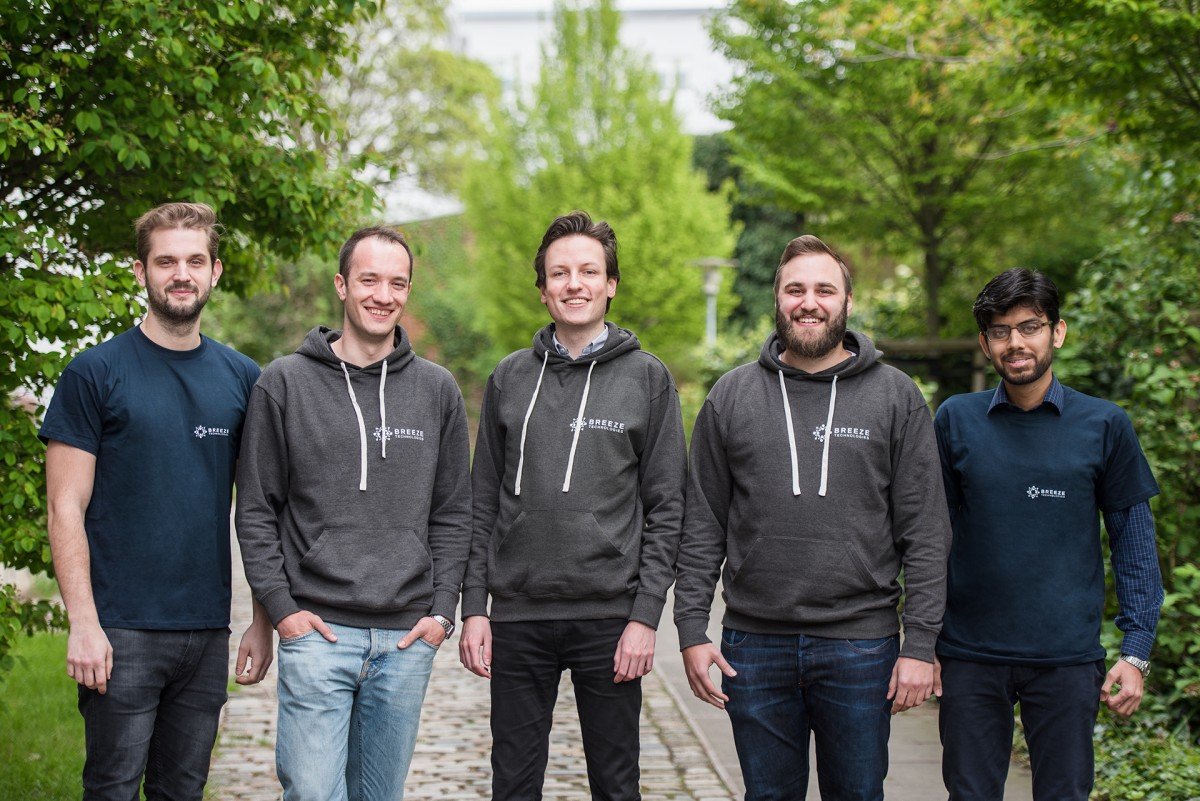
As adults, we take 15 to 20 breaths per minute. The one who lives in the countryside is lucky. Because nobody in the city knows exactly what air they are drawing through their lungs. And with which – possibly harmful – substances they supply their body. That can change immediately. In 2015, the two computer scientists Robert Heinecke and Sascha Kuntze already founded the company Breeze Technologies in Hamburg. With the air sensor technology developed by the start-up as well as the appropriate infrastructure, everyone can find out about the air quality at their location. While Heinecke is Chief Executive Officer at Breeze today, Kunze took over the position of Chief Technology Officer of the steadily growing company.
AN INTERACTIVE MAP OF AIR QUALITY
Breeze’s product is in demand worldwide: the young entrepreneurs not only offer air quality sensors but also convince with their structured preparation and processing of the data in a clear form. For this, the company provides an interactive map as a citizen information portal on its website. On this, you can already find out about the quality of the air at some locations. However, the more comprehensive the small sensor boxes developed by the Hamburg-based company are used, the more precise the information will be.

Urban development is a first relevant area of application,” Heinecke says about Breeze’s goals, “any city that wants to make life better for its citizens, that plans the life in the city of tomorrow today, should be able to provide data on air quality and intervene in real time to improve it.”
And Breeze has specialized in precisely this topic. The sensors, which are only about 9 cm tall, measure all the indicators that the World Health Organization (WHO) has identified for determining air quality. These include temperature and humidity, carbon monoxide (CO), carbon dioxide (CO2), nitrogen monoxide (NO), nitrogen dioxide (NO2), particulate matter (PM10 and PM2.5), sulphur dioxide (SO2), ozone (O3) and ammonia (NH3).
FAST SOLUTION OF QUALITY PROBLEMS POSSIBLE
Breeze collects all this data in real time with a measurement interval of 30 seconds. This allows potential problems such as congestion to be identified immediately. The information, in turn, enables the city management to defuse these immediately and actively initiate countermeasures. Thanks to artificial intelligence, the Breeze Technologies platform learns more with every air pollution control measure: Because the real-time air quality data also makes it possible to measure success immediately, the knowledge gained in this way can be used directly in the next projects. Additionally, the sensors can also be used to analyze and optimize the impact of construction measures on urban climate.
By the way, the sensors can also be used in office buildings. Here, the data is supplemented at the same time with smart solutions for air improvement – such as applying wall coatings with photocatalytic effects, i.e. sunlight, or moss walls for air filtering.
HOW EVERYONE CAN GET CLEAN AIR
Although there are also measuring devices for air quality in the final customer sector, Heinecke says: “I don’t know of any where I am satisfied with the quality of the data. Measurement accuracy and reliability is one of the biggest challenges in the very scientific field of air quality measurement. That’s why we publish detailed information on how we calibrate our instruments and how accurate they are.” Heinecke suggests that private individuals participate better in projects to improve air quality and, for example, request detailed information on the current situation from public authorities. An overview of air quality can be found on the citizens’ portal mentioned above. All public measuring stations are also integrated there. Municipal authorities should be able to provide information on air quality in the streets. But one should also receive more information, such as real-time data. Breeze cooperates with NGOs – for example, the technology for an air monitoring network along the Elbe, initiated by NABU, was developed by Breeze.
The city of Eindhoven has tried to solve the problem with a pilot study “Lungs of the City”
VISIONS
Breeze currently manages projects in the cities of Hamburg, Neckarsulm, Hennef and Moers. Recently the air monitoring network in Neckarsulm went online. Now the first feedback is eagerly awaited. In addition to the cities, the two Hamburg residents are also working with companies to further expand their solutions. The start-up is even represented in several European countries and in business outside Europe.
The collected data is to be integrated for further application scenarios in the future. For example, asthmatics could decide when and where they want to go out for sports, such as running, on the basis of current air quality data covering the entire area. Heinecke also points out further visions:
Imagine your running app generating the healthiest running route from your position at the current time. Or that you will receive detailed information about the average air quality in the street when you next look for an apartment. We’re working hard to make this possible in the future.”
BACKGROUND
Breeze Technologies UG was founded in 2015 as part of a European innovation and accelerator program for smart cities. The company’s team consists of scientists, engineers, analysts, computer scientists, designers and former consultants with international professional experience. The young entrepreneurs also worked closely with well-known research institutes and universities such as Hafencity University and the University of Hamburg. Following funding from several EU start-up programs, the company – alongside established companies such as Bosch Sensortec and Siemens – was named a key start-up in MarketsAndMarkets‘ latest study of the environmental sensor market. In addition, Breeze Technologies was recognized by the European Parliament as one of the most promising startups in the European Union. Last but not least, the founders Robert Heinecke and Sascha Kuntze are among the most important European social entrepreneurs in the Forbes 30 Under 30.
The company video explains the technology in greater detail:
With Aireas, Eindhoven also has a very active group of people concerned about air quality.

